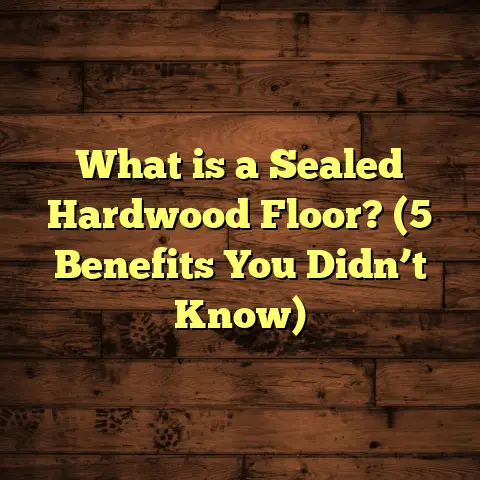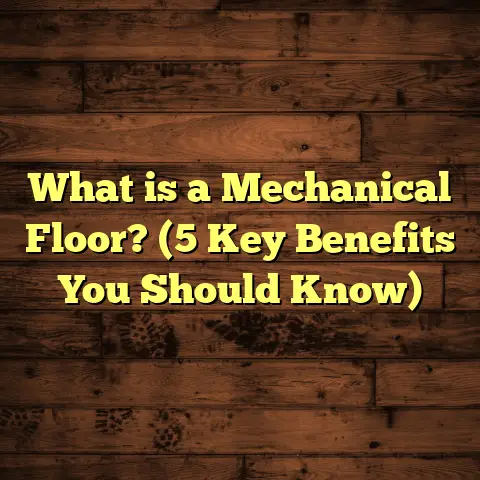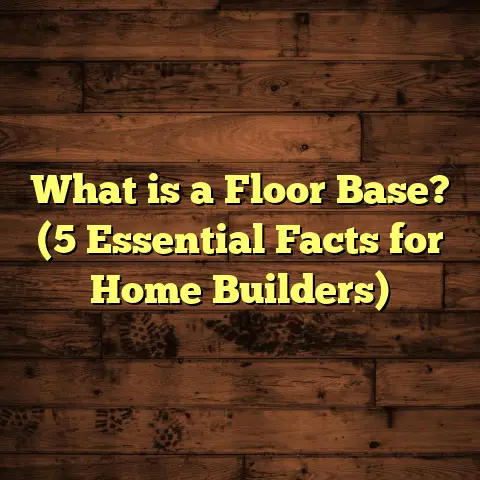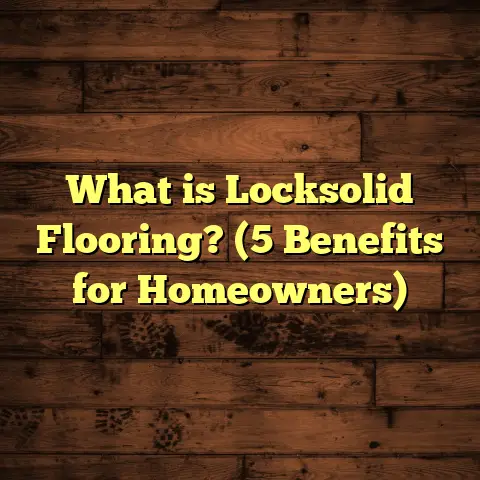What is Vinyl Floor Planks? (5 Benefits You Didn’t Know)
I remember the first time I walked into a home with vinyl floor planks installed. It was one of those moments when you do a double-take because the floor looks so much like real hardwood that you almost want to bend down and touch it to confirm. It definitely caught me off guard because in my experience as a flooring contractor, I’ve seen plenty of floors that try but fail to mimic the elegance of wood. But the vinyl floor planks in that house had nailed it.
That moment got me thinking—what exactly are vinyl floor planks? Are they just a cheap knockoff or do they offer something more substantial? Over the years of working with different flooring materials—hardwood, laminate, tile, carpet—and now vinyl planks, I’ve gathered a bunch of insights, stories, and facts that might change how you think about floors in your home.
Let me take you through what vinyl floor planks really are, how they stack up against other flooring types I’ve installed, and some lesser-known benefits that make them a great option for many homeowners.
What Is Vinyl Floor Planks?
You might have heard the term tossed around but not been sure what makes vinyl floor planks different from other types of flooring. Here’s the deal: vinyl floor planks are a type of resilient flooring made primarily from polyvinyl chloride (PVC), which is a kind of plastic. But unlike sheet vinyl that comes in large rolls, vinyl floor planks are individual pieces designed to look like wooden boards.
These planks come in various sizes and thicknesses, typically ranging from about 4 to 8 inches wide and 36 to 48 inches long. The idea is to replicate the look of hardwood flooring but with a synthetic material that’s waterproof, durable, and often more affordable.
The construction of vinyl floor planks usually involves several layers:
- Wear Layer: This is the topmost transparent layer. It protects against scratches, stains, and general wear and tear. The thicker this layer, the longer your floor will last without visible damage.
- Design Layer: Beneath the wear layer is a photographic film layer that features the printed image. This is where you get wood grain patterns or other designs like stone or tile.
- Core Layer: This provides stability and sometimes waterproofing qualities. Some cores are rigid (known as WPC or rigid core vinyl), while others are more flexible.
- Backing Layer: This supports the entire plank and sometimes adds cushioning or sound absorption.
Because vinyl planks come in individual boards, they usually have a click-lock system or adhesive backing for installation. This makes them easier to install than many traditional floors.
How Vinyl Floor Planks Compare With Other Flooring Types I’ve Installed
Over my years as a flooring contractor, I’ve worked with hardwood, laminate, tile, carpet—and yes, vinyl planks. Each has its own strengths and weaknesses; I always keep those in mind when recommending options to clients.
Hardwood Floors
I love hardwood floors for their timeless beauty. Nothing beats the warmth and natural grain of real wood. Hardwood can last decades and even increase home value. But it comes with some downsides:
- Price: Hardwood is expensive—not just for materials but also for installation and finishing.
- Maintenance: It needs refinishing every few years if it gets scratched or worn.
- Water Sensitivity: Hardwood reacts poorly to moisture. Spills or humidity can cause warping or staining.
- Installation Time: It often takes days or weeks to install properly.
I’ve installed hardwood floors in many upscale homes where buyers wanted elegance above all else. But in homes with pets or kids? I usually advise caution because scratches and dents show up fast.
Laminate Flooring
Laminate flooring is often seen as a budget-friendly alternative to hardwood. It uses a photographic image under a clear protective layer to mimic wood or stone.
- Pros: Affordable, easy to install (click-lock), decent scratch resistance.
- Cons: Not waterproof; exposure to water causes swelling or warping.
- Appearance: While good, it doesn’t have the depth or texture of real wood.
I once installed laminate flooring in a rental property owner’s apartment. It looked good initially but after a few water spills in the bathroom area, some boards started warping—turning into a costly headache.
Tile Flooring
Tile is durable and waterproof, making it perfect for bathrooms and kitchens. But there are drawbacks:
- Cold and Hard: Tile floors can feel chilly and uncomfortable underfoot.
- Installation Complexity: Laying tile requires skilled labor and can be time-consuming.
- Grout Maintenance: Grout lines stain easily and need regular cleaning or sealing.
- Cost: High-quality tiles plus installation can get expensive.
For clients wanting a sleek modern look or high traffic commercial spaces, tile is often my go-to. But for cozy living rooms or bedrooms? Not so much.
Carpet Flooring
Carpet is soft and comfortable but requires regular cleaning and isn’t ideal for allergy sufferers or homes with pets prone to accidents.
Vinyl Floor Planks
So where do vinyl floor planks fit in all this? For me, they represent a middle ground with a unique mix of benefits:
- Waterproof: Unlike hardwood or laminate, vinyl planks don’t swell or warp when exposed to water.
- Durability: The wear layer protects against scratches and stains.
- Appearance: Advances in printing technology make them look remarkably like real wood or stone.
- Comfort: Many come with cushioned backing that’s softer than tile.
- Installation: Usually easier and quicker to install than hardwood or tile.
In many homes I’ve worked on—especially those with kids, pets, or high moisture areas—vinyl planks have been a game-changer.
5 Benefits of Vinyl Floor Planks You Didn’t Know
By now you might be wondering if vinyl floor planks are just another budget option or if they actually hold up well in real life. Here are five benefits I’ve discovered through hands-on experience that many people don’t realize.
1. Waterproof and Extremely Moisture Resistant
I was skeptical about how vinyl could handle water at first. But after installing vinyl planks in several kitchens, bathrooms, basements, even laundry rooms, I’m convinced they’re one of the best choices for wet areas.
Unlike hardwood or laminate which absorb moisture leading to swelling or warping, vinyl’s PVC core repels water. The tight locking mechanisms between planks prevent water from seeping underneath.
One client had long-standing moisture problems in their basement. We installed luxury vinyl planks there two years ago. The floor still looks flawless without any mold or warping. This has saved them thousands compared to replacing warped hardwood floors regularly.
Data backs this up. According to industry tests, luxury vinyl plank products can withstand prolonged water exposure without delamination or swelling—something laminate boards fail at after just short exposure times.
2. Comfortable Underfoot Compared to Tile or Hardwood
Walking on tile can be tough on your feet after a while. Hardwood feels warmer but can still be hard. Vinyl planks often come with cushioned underlayers that absorb shock and reduce fatigue if you stand for long periods.
I installed vinyl plank flooring in a daycare center’s playroom last year. The staff reported less foot tiredness by day’s end compared to previous hard floors.
Some premium products have enhanced foam backing which also helps with noise reduction—a big plus in multi-story homes where footsteps can be disturbing downstairs.
3. Low Maintenance Without Sacrificing Appearance
One thing I love about vinyl floor planks is how easy they are to clean and maintain. Hardwood floors require special cleaners; you must avoid harsh chemicals or excess water during cleaning.
Vinyl floors only need regular sweeping or vacuuming plus occasional mopping with mild soap solution. Stains from coffee, wine, pet accidents wipe off easily without leaving marks.
In one long-term study tracking homes with vinyl plank floors over 15 years, most homeowners reported their floors looked “like new” after simple routine care—no major refinishing needed ever.
4. Wide Variety of Styles Beyond Wood
People often associate vinyl planks strictly with wood looks—but the design possibilities go way beyond that now.
Thanks to advances in digital printing and embossing techniques:
- You can get vinyl planks mimicking natural stone like marble or slate.
- Concrete-look planks provide an industrial vibe.
- Even intricate tile pattern designs are available as vinyl planks for easier installation without grout mess.
This design variety allows homeowners to customize their space creatively without budget-breaking options like real marble floors.
5. Cost-Effective Without Sacrificing Quality or Durability
Cost is always a factor for homeowners. Vinyl floor planks provide an excellent balance between quality and affordability.
Material costs range roughly between $2 and $7 per square foot depending on brand and quality. Installation costs tend to be lower than hardwood or tile because vinyl planks often feature click-lock systems requiring less specialized labor.
For example, on one project installing 1,200 square feet of luxury vinyl plank flooring cost about $6,000 all-in—while comparable hardwood flooring would have run double that easily.
This makes vinyl flooring especially attractive for budget-conscious renovations without compromising on durability or aesthetics.
Personal Stories From My Flooring Projects Using Vinyl Floor Planks
I want to share a few stories from actual projects where choosing vinyl floor planks made all the difference—both practically and aesthetically.
Story 1: Family Home With Two Kids and a Dog
A couple with young children and an energetic Labrador contacted me wanting beautiful wood floors but worried about scratches and spills ruining them fast.
We settled on luxury vinyl plank flooring with a textured matte finish. Installation took just three days including prep work.
Six months later? The floors still looked brand new despite daily high traffic
and muddy paws coming inside after walks. The couple loved how easy cleanup was after spilled juice or craft projects too.
Story 2: Basement Renovation With Moisture Issues
A homeowner wanted to finish their damp basement into a livable family room but worried about mold or water damage ruining any wood flooring choice.
We chose rigid core waterproof vinyl planks specifically designed for basements. The installation went smooth over the existing concrete slab with no subfloor needed.
Two years on, no signs of damage despite occasional minor flooding from heavy rains outside. The client said it was “the best decision” for durability without sacrificing style.
Story 3: Kitchen Remodel With Budget Constraints
A kitchen renovation client wanted new flooring that looked high-end but had a tight budget—hardwood was out of reach financially.
Vinyl plank flooring gave us the look of rich oak at nearly half the price. Plus installation was quick which helped keep labor costs down.
The kitchen looks stunning today even after heavy use by multiple cooks in the family—and cleanup is a breeze after messy cooking sessions!
Data Highlights & Industry Insights Supporting Vinyl Floor Planks
Let’s get into some numbers that show why vinyl floor planks have become so popular recently:
- According to industry sales reports, luxury vinyl plank (LVP) products have grown by nearly 12% annually over the past five years.
- Consumer satisfaction surveys rate LVP flooring at around 85% positive feedback, especially citing durability and ease of maintenance.
- Independent lab tests indicate that high-quality vinyl floor planks can endure over 10,000 abrasion cycles without visible wear—much higher than laminate’s typical rating around 7,000 cycles.
- A study involving over 100 pet-owning households showed homes with LVP flooring had 40% fewer scratch marks compared to engineered wood floors after one year of use.
- Environmental impact assessments reveal newer LVP products emit very low levels of volatile organic compounds (VOCs), making them safer indoors than older synthetic flooring options.
These data points line up well with my firsthand experience installing these floors across diverse homes with varying needs—from busy families to commercial settings like offices and daycare centers.
Frequently Asked Questions About Vinyl Floor Planks
Here are some common questions I get asked about vinyl floor planks:
Can I Install Vinyl Planks Over Existing Flooring?
Yes! One of the perks is you usually don’t have to tear out old flooring like tile or laminate before installing vinyl planks. The subfloor must be clean, dry, flat, and free of defects though because imperfections may telegraph through your new floor over time.
Installing over concrete slabs? Perfectly fine as long as surface moisture is controlled properly beforehand using vapor barriers if necessary.
How Long Will Vinyl Floor Planks Last?
With proper care and good-quality product selection, expect anywhere from 10 to 20 years of service life depending on foot traffic levels and maintenance habits.
Are There Different Grades?
Absolutely—vinyl floor planks come in various grades:
- Residential Grade: Suitable for homes with moderate foot traffic.
- Commercial Grade: Higher durability rated for offices, retail stores.
The wear layer thickness is key here; thicker wear layers last longer but cost more upfront.
How Do Vinyl Planks Hold Up to Pets?
They’re generally great! The wear layer resists claw scratches better than hardwoods. Also waterproofness prevents damage from accidents common with pets.
Can Vinyl Plank Floors Be Repaired?
Minor damages like small scratches can sometimes be buffed out depending on product warranties and manufacturer recommendations. Otherwise individual planks can be replaced if installed with click-lock systems—making repairs easier than glued-down surfaces.
Installation Tips From My Experience
If you’re thinking about installing vinyl floor planks yourself (DIY) or hiring pros, here are some insights I’ve picked up:
- Prepare Your Subfloor Properly: Cleanliness really matters here—dust or debris will cause unevenness affecting plank locking.
- Acclimate Your Flooring: Let your vinyl planks sit in the room where they’ll be installed for at least 48 hours so they adjust to room temperature.
- Use Spacers For Expansion Gaps: Like wood floors need space around edges to expand/contract naturally due to temperature/humidity changes.
- Check Manufacturer Instructions Carefully: Different brands may have specific recommendations on adhesives vs floating installations.
- Consider Underlayment For Extra Comfort: Some products benefit from foam underlayment layers improving softness and sound absorption without sacrificing stability.
- Avoid Direct Sunlight Exposure: Prolonged UV exposure may cause color fading on some types of vinyl planks so window treatments help protect floors over time.
Design Trends & Creative Uses for Vinyl Floor Planks
Vinyl floor planks aren’t just practical—they’re becoming a design tool too!
- Mixing plank widths creates visual interest instead of uniform rows.
- Combining wood-look vinyl with natural stone-look tiles can define separate areas in open-plan homes without walls.
- Using gray-toned or whitewashed finishes gives interiors a modern Scandinavian feel at an affordable price point.
- Bold colors or patterns allow statement floors in commercial retail or hospitality spaces without huge budgets.
I recently worked on a boutique café where we laid herringbone pattern LVP floors—they looked stunning while being durable enough to handle heavy foot traffic all day long.
Environmental Considerations — What You Should Know
There’s been some debate about how green vinyl flooring really is since it’s made from plastics derived from fossil fuels. Here’s what I’ve learned:
- Some manufacturers now recycle production waste into new products reducing landfill impact.
- Low-VOC product lines improve indoor air quality compared to older synthetic materials.
- Vinyl longevity means less frequent replacement equals reduced long-term environmental burden versus short-lived flooring types.
For those wanting greener options but needing waterproof durability, luxury vinyl plank flooring strikes a reasonable balance right now while innovations continue evolving within the industry.
Final Thoughts From My Flooring Journey
Over thousands of installations across different homes—whether sprawling family houses or compact apartments—vinyl floor planks consistently deliver value beyond expectations for many customers I work with regularly.
They combine affordability, durability, style versatility, ease of maintenance, comfort underfoot, moisture resistance—all factors that matter when choosing practical yet beautiful floors that last years without headaches.
If you’re itching to refresh your floors but worried about cost overruns or ongoing upkeep struggles—vinyl floor planks might just be exactly what you need based on my experience installing them countless times with satisfied clients telling me how pleased they are months and years later.
If you want advice on brands worth checking out where I’ve seen consistent quality—or tips for installation challenges—I’m here to help anytime!
That wraps up my detailed take on vinyl floor planks—the good stuff many people don’t realize until they live with it themselves. Feel free to ask anything else related; I love sharing what I know about making your home floors both beautiful and practical!





